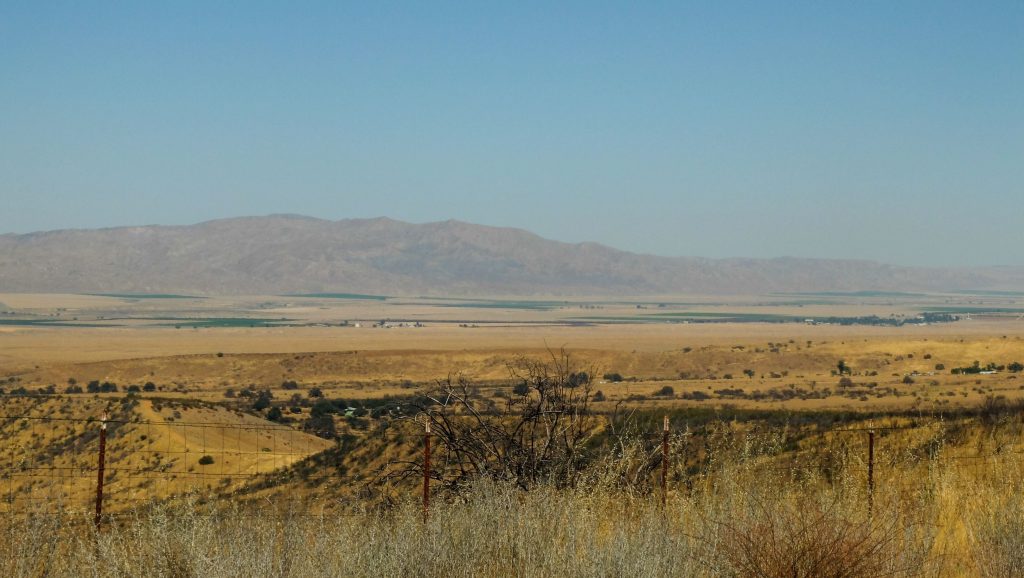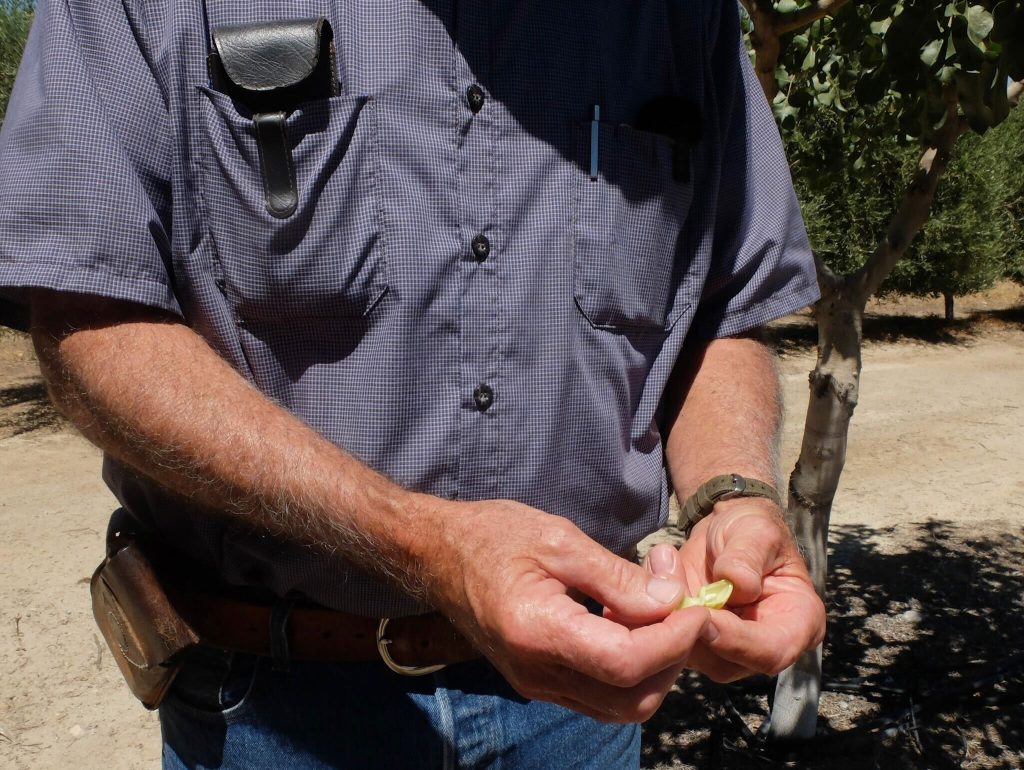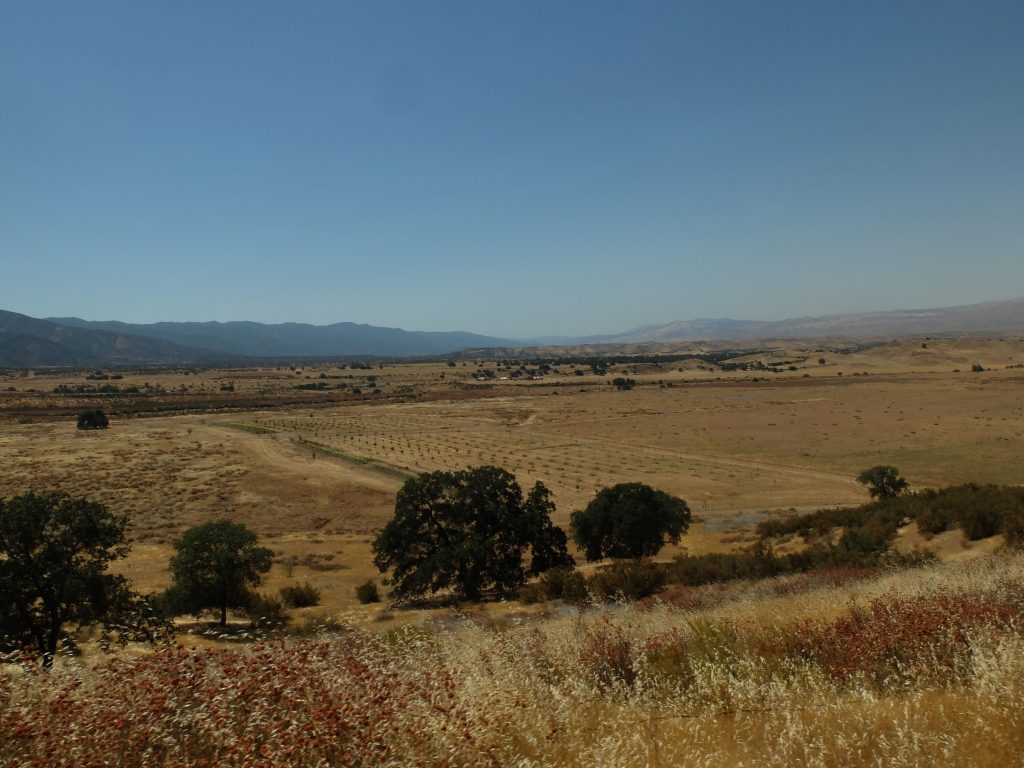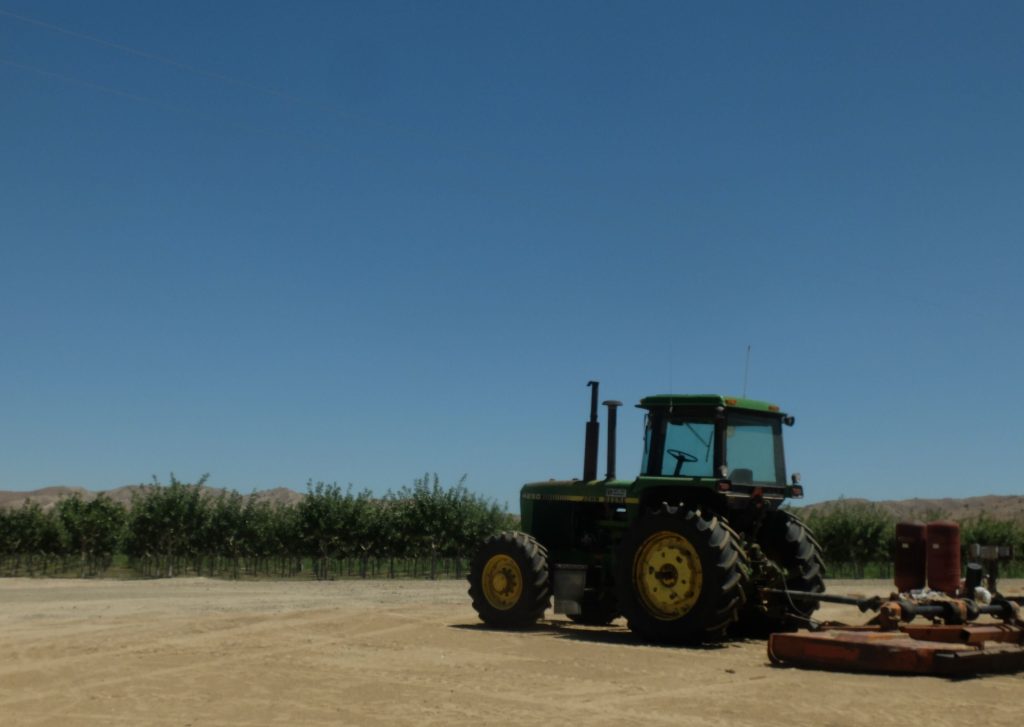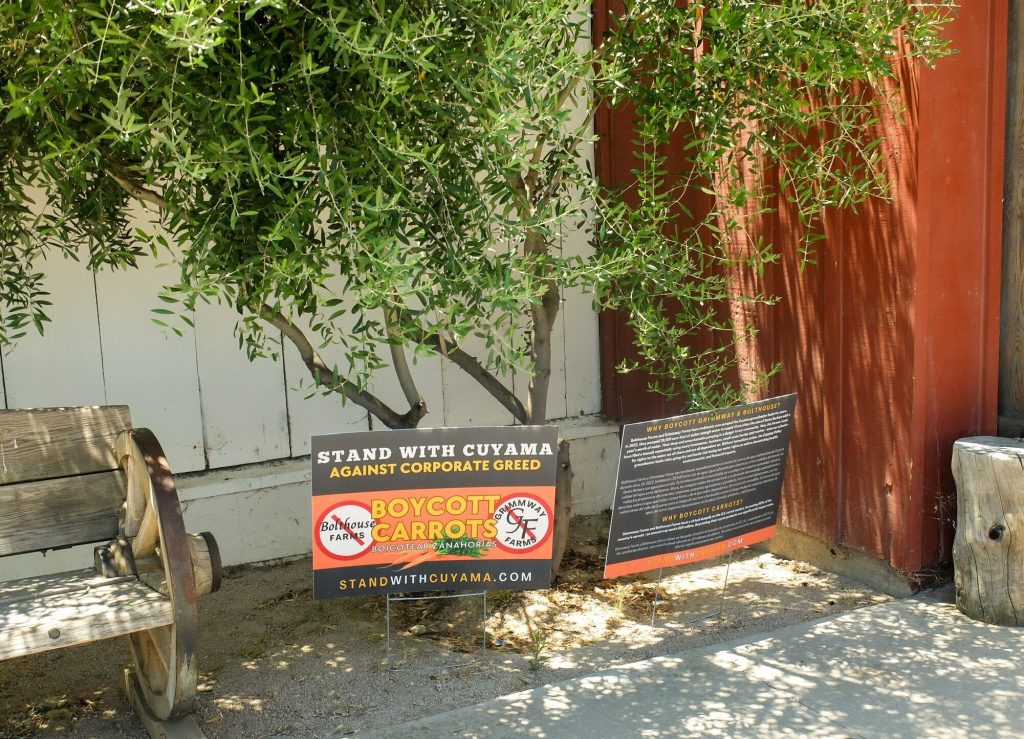The Cuyama Valley Water Wars, Part 1
Story by Rosie Bultman and Joyce Chi || Photos by Joyce Chi || Listen to the story on SoundCloud || Link to Part 2
—
BOSMA: It’s bleeding everybody in this valley. And the reality is that Grimmway and Bolthouse know this is an impoverished community. They know what they’re doing. If they don’t, like, I can’t speak to what their mindset is. I can’t speak to their mindset, but I can look at their actions and make some assumptions, right? And my assumptions looking at, I mean, I don’t know how large hedge funds type corporations, whatever they are, they don’t make mistakes, right? They make calculated decisions, and their calculated decision was to attack this valley in this manner fiscally, as well as to try to basically steal the water rights from everybody else in the valley. And when I mean everybody, I mean everybody. Our school district, our water district, our churches, our nonprofits, our small business owners, our farms, our ranches, our community members that live in the town site.
The residents of Cuyama Valley are at risk of losing their water rights.
In 2021, two major carrot growers in the area – Grimmway Farms and Bolthouse Farms – filed a lawsuit against Cuyama residents over water usage. This type of lawsuit is called adjudication, and it tries to determine how much water someone owns or can use.
Grimmway Farms and Bolthouse Farms initially claimed the adjudication lawsuit was a fair process to determine water rights, a claim that residents – and experts – dispute.
KCSB News has been investigating the Cuyama Valley Water Wars, and will be airing a two part feature on the topic.
In Part 1 we’ll examine the background of this case. On Monday, in Part 2, we’ll discuss the lawsuit, its impact on residents (and how they fought back), and where the lawsuit stands today.
I’m Rosie Bultman. This is The Cuyama Valley Water Wars, Part 1.
~~
The Cuyama Valley, as its travel website says, is “perfectly in the middle of everywhere.”
Hot, arid, and sparsely populated, it lies along the Cuyama River and within Santa Barbara, Ventura, San Luis Obispo, and Kern Counties.
When we say “sparsely populated,” we mean it. Less than 1,500 people live in one of three “population centers”: New Cuyama, Old Cuyama (or just Cuyama), and Ventucopa.
Here’s Charlie Bosma, a rancher and retired deputy sheriff who you heard at the beginning, describing the community.
BOSMA: Fiscally impoverished. Very tight knit, very supportive. We’re able to survive and overcome things with each other’s help. We’re very independent in a lot of respects, and very live and let live in the sense of how we approach our community.
The average annual household income in the area is around 55 thousand dollars. For the lowest-income households – those making less than 20 thousand dollars a year – bottled water is a major expense, accounting for more than 7 percent of total income. When there’s so few people around, it becomes more expensive to pay for water systems. That’s according to a study by Casey Walsh, a professor of anthropology at UCSB who has done extensive research on Cuyama’s water crisis, who you’ll hear from later.
WEGIS: When oil came in the 60s, it was basically a middle-class, working-class community in the town of New Cuyama, and that’s where most of the people were.
That’s Jim Wegis, a third-generation Cuyama Valley farmer who lives in Ventucopa.
WEGIS: That’s when I grew up, and it was a great place to be. We were probably behind times in a lot of the things going on, but it was family-oriented, and it was a good place to be.
Jim took us around his farm and showed us his crops, which take years to grow and be ready for harvest.
WEGIS: This is a pistachio. See, it’s been bruised. See that? That white thing will be the nut. They grow clusters, like grapes. They’ll be big ones, and they’ll be all over the tree. Pistachios are clusters. As you get a big tree, there’s lots of these…This is one variety of olives, and these are… This is all for oil. All of this is done mechanically. The flesh is where the oil is and they will get quite a bit larger.
Jim’s great-grandparents came to the Cuyama Valley in 1852 from Ojai and Ventura. He said he’s lived nearly his entire life in Cuyama, and has seen first hand the changes the Valley has gone through.
According to Jim, Cuyama Valley was initially an agriculture and ranching town. Then irrigation and oil came in the late 1940s and 1960s. From his perspective, Ventucopa – his hometown – hasn’t changed as much as the central part of the Valley.
WEGIS: The oil fields don’t use near as many people. They’re automation, and the same in agriculture… // The price of labor has gone up. All costs have gone up, so we’ve had to become more and more efficient to survive. Agriculture is an industry throughout the United States that uses less people than it used to.
It isn’t just automation. Charlie Bosma has noticed a decrease in small farms in the Valley.
BOSMA: Large corporations are systematically buying up land, changing them from family farms into corporate farmland.
Charlie said he’s heard talk for years that big corporations might eventually become a problem for locals. He says the “live and let live” attitude at the center of residents’ respect for each other may also have exacerbated the situation.
BOSMA: We’ve been so live and let live and not making an issue of what somebody else is doing with their property and their resource…I have listened to people talk about the water problem…more so in the jest of people saying, “oh, you know, in 10 or 15 years, this valley is going to be a dust bowl because of how much water these large corporations are using.”
For residents of the Cuyama Valley, the only source of water – and the kind of water at the center of this lawsuit – is groundwater.
Groundwater forms when rain or snow seeps through the earth and accumulates between rocks underground. This is a process that takes hundreds of millions of years, according to Professor Casey Walsh, and the water that’s pumped out can be tens of thousands of years old.
WALSH: So places like Cuyama Valley – they have this immense resource of groundwater underneath them. That’s what’s so attractive to agriculture. You can basically put a well in anywhere and get water just by flipping a switch, which makes it very easy to grow delicate crops.
For big farms like Grimmway and Bolthouse, Cuyama Valley is the perfect resource, with its once-abundant groundwater and its extreme temperatures that make it difficult for insects and pests to live. But Cuyama’s water resources are depleting, which means they don’t have access to the water that they want to conduct their large-scale operations.
Here’s Professor Walsh again.
WALSH: Basically, groundwater levels were falling rapidly. The qualifiers were being pumped out to support agriculture. And this is a process that’s been happening for a long time.
Chances are, the carrots you consume on a daily basis come from Grimmway Farms or Bolthouse Farms — they are that big. The two farms, which came to Cuyama in the 1980s, are responsible for eighty percent of the US carrot market, raking in sixty-nine million dollars annually.
Despite their outsized presence in the Cuyama Valley, many residents do not consider Grimmway Farms and Bolthouse Farms as part of the community.
BOSMA: When a decision based on how much water goes on a field is made by Somebody in an office in Bakersfield or somebody in a corporation office in New York that there’s no concept to What’s appropriate for the land?
Grimmway Farms and Bolthouse Farms are both headquartered in Bakersfield. Bolthouse Farms’ parent company, Butterfly Equity, is based in Beverly Hills, while Grimmway Farms’ parent company, Teays River Investments, is based in Zionsville, Indiana.
Also, many of the people who work in agriculture in Cuyama don’t actually live there.
Professor Walsh explained this further.
WALSH: The workers come and go, and they live in the Central Valley, and they spend their wages in the Central Valley. The businesses don’t really leave anything there. There’s no sort of derivative economy from this carrot production. It really just looks like an enclave, kind of like a little isolated production zone that really doesn’t generate anything locally, doesn’t generate any sort of expansion or economic growth or prosperity. That’s one of the things that people in the Valley recognize, that there are these enormous companies in the Valley using their water and land, but really not leaving very much there at all.
Charlie Bosma emphasized that he has no problem with the workers that come in to work on Grimmway and Bolthouse farms. He cites a tragic incident to illustrate his perspective that Grimmway and Bolthouse are harmful on multiple levels: the September 2023 death of 58-year-old Rosa Miriam Sanchez on a carrot field in New Cuyama operated by Grimmway Farms.
BOSMA: It’s not with the guys who moved the pipe. It’s not with the guys who pull the weeds like it’s not with I mean if you look it up We had a horrible tragedy out here a Year ago now and I can send you the information on it if you want to see it and it just goes to show the mindset and the ideology of this giant machine right and We had contract laborers up they were out in a field a Tractor operator I’ve Tractor operator truck operator. I can’t remember if he’s driving a truck or tractor ran over a field worker and killed her in front of her daughter and They stopped and literally moved them like rose over and told them to keep picking parents That’s not humane that’s inhumane
In a statement on Instagram after Sanchez’s death, Grimmway Farms said they were cooperating with a state investigation and would be launching their own.
In 2021, Grimmway and Bolthouse Farms filed a water usage lawsuit against the residents of Cuyama.
This adjudication lawsuit comes after the passage of the Cuyama Valley’s Groundwater Sustainability Plan, or GSP.
The Cuyama Basin is one of 21 critically overdrafted basins in California, which means the amount of water taken out of the basin was greater than its long term annual supply of water. Overdrafted basins can have adverse impacts on the environment, and don’t bode well for a community’s long-term water supply.
Jim Wegis says that Grimmway and Bolthouse are the largest water pumpers in the Valley.
WEGIS: Everybody in the main basin down there, Grimmway and Bolt House are the two largest pumpers in the valley. So their majority responsibility. If you just look at the straight numbers, they pump the most water, they farm the most ground, but they pump the most water so they’re most responsible. And they can’t argue that point. Did they break the law in doing any of that to this point? No.
He also illustrates what pumping water looks like for him, as a small independent farmer. This differs from the pumping that agricultural giants Grimmway and Bolthouse do.
WEGIS: The deepest well I have is 240 feet deep. You go down the road a mile and they’re 1200 feet deep. And 240 feet will not even get close to the water table. So that is the main difference.
In 2014, the state passed the Sustainable Groundwater Management Act, or SGMA (“sigma”). This bill requires local governments to create groundwater sustainability plans, or GSPs.
Professor Casey Walsh says SGMA was a landmark piece of legislation, as prior to its passage, there was little to no regulation for groundwater usage. There was only Article 10, Section 2 of the California State Constitution, which requires that water resources, quote, “be put to beneficial use to the fullest extent of which they are capable,” end quote.
Walsh also cites something called the “correlative rights doctrine.”
WALSH: The courts would decide whether this person extracting water from their parcel was harming others’ access to that water.
But the Sustainable Groundwater Management Act changed that. Instead of adjudication and fighting it out in courts, people – local officials, residents, and others – could collaborate on a plan to responsibly handle a region’s water resources.
Cuyama’s GSP was drafted by a Board of Directors and a Standing Advisory Committee. The Board includes many local officials – like Supervisor Das Williams, while the Advisory Committee includes local residents, like Jake Furstenfeld.
FURSTENFELD: I felt empowered that I was able to help be a productive part of this process.
After SGMA was passed in 2014, Jake says that they quickly got to work on drafting the GSP.
The most recent version of the Cuyama Basin’s Groundwater Sustainability Plan is 455 pages long and is available at cuyamabasin.org. Among the critical provisions is this: based on current data, groundwater usage in the area needs to be cut by as much as 50 to 67 percent. It’s important to note, though, there will be ongoing evaluations and studies to update those figures.
There are four phases of the Cuyama GSP, with the goal of achieving basin sustainability by 2040.
But even before the GSP was finalized, Jim Wegis changed the crops he grew, since water-intensive crops had become too expensive to maintain. (The deeper you go to pump water, the more electricity you have to use.) Jim used to grow alfalfa, but switched to olives and pistachios, which use around 50% less water.
WEGIS: This whole valley, basically the whole valley used to be in alfalfa, which was five to seven acre feet per acre water usage. And then it, the main part of the basin down there left when energy prices started. And I’m talking in the 60s, the energy prices started going up, alfalfa kind of went out. And then the price of hay came back up, and maybe in a 10 year period there wasn’t very much, there was potatoes and there were some other higher value crops. And then alfalfa came back, I used to farm, all of this was in alfalfa. But seeing handwriting on a wall, I I that that wasn’t going to be good in the long run, because you could see water, because water was becoming very, and it wasn’t so much here. And honestly I wanted to try growing some trees, I grew trees in the past, theoretically so we could get away more, but it hasn’t worked. That’s a big plan. It has helped, but but you’ve got to be here all the time too. And so our water usage is less than half of what we were using.
Besides local officials from the county and water agencies, the Board of Directors also includes representatives from Grimmway and Bolthouse including Derek Yurosek from Bolthouse Farms and Grimmway’s George Cappello. Representatives from Grimmway and Bolthouse served on the Board, even throughout the lawsuit.
FURSTENFELD: They’re going to want to influence the process to help benefit their needs, right?…It felt like this whole time, they want to cut back as little as possible. One of them was like, let’s not cut back to 2035. Are you kidding me? 2035? We could be out of water by then. They were going for their company’s best interest, but the majority of the community was going for sustainability. The goal is sustainability from day 1.
Despite their involvement throughout the process, the two farms decided to pursue a lawsuit.
BOSMA: There’s no good faith there, right. Like you don’t sit on a panel, create a document and we’re not talking about something that they threw together with like legal zoom in 15 minutes. This was over, I want to say, four or five years to create this document and to sit and to try to come up with something that was fair for everybody. That gets sent off to the state. They sue everybody.
In a statement to KSBY in 2023, Bolthouse Farms confirmed that every landowner in a basin that’s being adjudicated needs to participate in the adjudication process.
However, Professor Casey Walsh reiterated that SGMA was comprehensive enough so that adjudication was unnecessary.
WALSH: The Sustainable Groundwater Management Act includes within itself everything that is needed to manage groundwater sustainability in a basin.
The high stakes of the lawsuit has sparked a carrot-boycott movement, formally known as Stand with Cuyama, organized by residents like Jake Furstenfeld and Charlie Bosma.
Shortly after the movement’s inception, in October and November of 2023, Grimmway and Bolthouse officially withdrew from the lawsuit. But the fight is far from over, as both farms have close ties to the property owners that remain involved.
As the lawsuit draws on, Cuyama residents fear for their livelihoods.
BOSMA: I think a lot of us believe that if they’re successful, they will destroy this community. And I mean, like you asked before, what do you do without water? Would you do nothing? You move, right?
KCSB News will continue the story of Cuyama Valley Water Wars on Monday’s newscast.
Thank you for listening, with KCSB news, I’m Rosie Bultman. This episode was also made possible by KCSB’s Joyce Chi.

